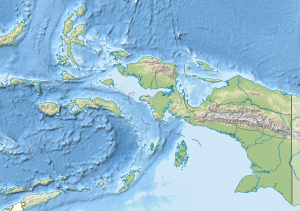Wetar
| Wetar | ||
|---|---|---|
| Wetar in the west of the Barat Daya Islands | ||
| Waters | Banda Lake | |
| Archipelago | Barat Daya Islands | |
| Geographical location | 7 ° 48 ′ S , 126 ° 18 ′ E | |
|
|
||
| length | 130 km | |
| width | 45 km | |
| surface | 3 600 km² | |
| Highest elevation | Hunun Arnau 1412 m |
|
| Residents | 6127 (2010) 1.7 inhabitants / km² |
|
| main place | Ilwaki | |
The tropical island of Wetar ( Indon. Pulau Wetar ) is the largest of the Barat Daya Islands ( Southwest Islands , as they are located southwest of Ambon ). With them it belongs to the Lesser Sunda Islands , but politically to the Indonesian province of Maluku . There it is part of the District ( Kecamatan ) Pulau-Pulau Wetar , Administrative Region ( Kabupaten ) Southwest Moluccas .
geography
To the south, across the Strait of Wetar , is East Timor (35 miles away). To the west, across the Strait of Ombai , is Alor Island . To the north the Banda Sea and to the east the other islands of the Kepulauan Barat Daya , Romang and Damar . In the southwest is the very small island of Liran ( Lirang ) and further away the East Timorese island of Atauro . The small island of Reong is located off the northwest coast of Wetar .
Wetar is 130 km long (east-west direction) and 45 km wide (north-south). The island has an area of 3,600 km². It is surrounded by coral reefs that are suitable for scuba diving. The highest point on the island is 1,412 meters above sea level.
The main cities on Wetar are Lioppa in the northwest, Ilwaki in the south, Wasiri in the north, Masapun in the east and Arwala in the northeast. Roads connect the villages with each other.
Wetar, along with the other Kepulauan Barat Daya and the Banda Islands, forms part of the volcanic island arc. Wetar, however, is not solely of volcanic origin, but consists largely of oceanic crust that has been raised to the surface by seismic activity. Here the Australian and Eurasian plates collide . The Gunung Api Wetar , a volcano 282 meters, broke out in 1512 and the 1699th
Wetar owns some gold mines , but they have been poorly managed and are environmentally harmful.
history
Wetar was part of the Republic of the South Moluccas .
Wildlife and climate
Wetar has the same climate as Timor . Rain almost only falls during the monsoon season . As a result, many of the trees in the forest that largely covers the island lose their leaves in the dry season. Together with its neighboring islands, Wetar is part of the Wallacea region , which forms the border between Asia and Australia. It is known for its unique fauna and Wetar is no exception. 162 species of birds live on Wetar , three of which are endemic and four are endangered. Several bear the name of the island, such as the wetar dove , the wetar red-winged parakeet ( Aprosmictus jonquillaceus wetterensis ) and the wetar iris lory ( Psitteuteles iris wetterensis ). The local zebra finch is also known to us . Together with Timor and some smaller, offshore islands Wetar was declared a Timor and Wetar Endemic Bird Area . Among the reptiles is the Asian Water Monitor with over two meters in length, the most prominent representative on the island.
Culture
Most of the population belongs to the Papuan peoples . Most are Muslims , but there is also a Christian minority.
Some of the Malayo-Polynesian languages of the Timor branch are only spoken on Wetar. Wetar ( Wetaresisch ) is also spoken on the neighboring islands of Liran and Atauro . In Wetar, the dialects Aputai , Ili'uun , Perai , Talur and Tugun are spoken . All of these languages are only used by small groups of around 1000 speakers. The official language Bahasa Indonesia and the regional language Ambonese Malay ( Ambonesian ) are widespread.
The population lives mainly from agriculture, predominantly sago palms are grown. Turtles are hunted and their shells are exported to countries that have not yet banned the trade.
Individual evidence
- ↑ Timor and Wetar deciduous forests. WWF
- ↑ Important Bird Areas in Timor-Leste (PDF file; 1.87 MB)


